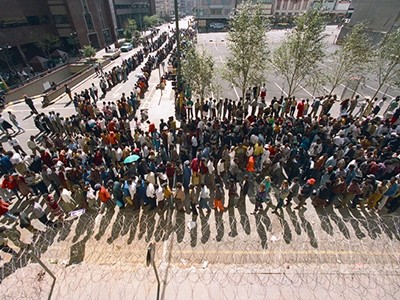How South Africa can move on from power cuts

South Africa is caught in an energy bind. From sunlight to wind and biomass, the country has an abundance of resources to generate renewable energy. But the nation’s power system is still largely reliant on fossil-fuel power plants, with scheduled power outages being the norm — until recently.
In the run-up to the country’s elections in May, Eskom, the state-owned power company that supplies almost 80% of South Africa’s electricity, stopped load shedding — the practice of scheduling outages, each lasting several hours, to lessen demand on the country’s ageing energy infrastructure. As South Africa’s incoming government takes shape, President Cyril Ramaphosa has indicated that the load-shedding battle is not yet over. With a concerted effort from the government, I know that power outages need not resume.
As a researcher working on energy optimization and the energy transition, I have studied the previous governmental efforts to end load shedding and found many ways through which the current energy system can be further optimized. More collaboration with consumers is also needed to better understand how, and when, they use electricity.
Nature’s message to South Africa’s next government: talk to your researchers
South Africa’s energy crisis began in around 2007, when Eskom became unable to meet the country’s energy needs and had to implement power cuts to decrease demand on the energy system. Since 2019, these outages have escalated to the point that, in 2023, power was unavailable to South Africa’s population for 78% of the year (see go.nature.com/3szorvd).
People and businesses have been hit hard. Many have faced insecurity and discomfort; appliances and electronics from refrigerators to laptops have been damaged; food has regularly gone to waste. Last winter, I endured cold nights with a sick infant, whose much-needed electric nebulizer to help treat pneumonia was rendered useless because of long power cuts. In townships, for example, by 2023, 64% of small businesses had to pause operations during periods of load shedding, 5% closed down altogether and 66% had to reduce employees’ working hours or even let them go.
Over the past decade or so, the government has implemented various measures to reduce pressures on the power grid. It has incentivized private energy generation, as well as energy efficiency — for example, encouraging people to consume electricity during non-peak hours. Renewable energies, including photovoltaic power generation, are on the rise. Scheduled plant shutdowns have been delayed. Some power plants have been converted to run on gas rather than diesel, and maintenance has been improved. But these steps have not been enough to avoid load shedding, which is projected to continue beyond 2030.
Meanwhile, wind and solar capacity has increased. But these resources are intermittent — and storage is costly. What’s more, solar- and wind-power generators are mostly located in areas with constrained grid capacity, so most of the energy produced cannot be transmitted widely.
‘Stop the xenophobia’ — South African researchers sound alarm on eve of election
There are several ways for the government to expand its efforts. First, support Eskom’s existing power-generating capacity by combining real-time fault-detection monitoring with continuous preventive maintenance. Maintenance schedules should be updated to take into account the country’s ageing infrastructure, rising energy demand and greenhouse-gas-emissions targets, in accordance with the United Nations’ Sustainable Development Goals.
Second, boost renewable-energy storage. Batteries are the most common storage option, and have been installed on Eskom’s Hex site in the Western Cape and in Elandskop, KwaZulu-Natal — but they are expensive. Other, potentially more sustainable options need to be explored. Pumped hydropower, for example — which stores water in two reservoirs at different elevations, generating power when water flows from one to the other — would work well. The method can stores more energy than batteries do and, importantly, store it over cycles lasting almost twice as long as those of most batteries.
Third, optimize the mix of energy sources in the power grid. But to maximize the contribution of each type of energy, many factors need to be taken into account. For photovoltaic energy, for example, these include the Sun’s irradiance; the power generated by solar cells; consumer energy demand; the costs of generating solar- and coal-based energy; and the capacity for energy storage.
Fourth, evaluate the robustness of the grid. Factors such as the type of technology used to generate energy, the generators’ locations, resource quantities, costs and demand vary. Models can aid grid assessment, planning and scheduling. They can help to optimize which type of energy (coal or solar, for example) should be dispatched at any time by quickly assessing the generator’s location, grid capacity in the area, quantity of energy generated and generation periods. Tools such as machine learning — which can process vast amounts of data in a short time — promise to boost the data-processing capability of such modelling.
Fortunately, South Africa already has the knowledge and expertise needed to develop solutions that will put an end to load shedding. Let us keep optimizing, measuring and optimizing again.
Competing Interests
The author declares no competing interests.
Source link





